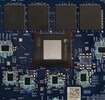Qualcomm Snapdragon X Elite X1E-78-100 vs Qualcomm Snapdragon X Plus X1P-46-100 vs Qualcomm Snapdragon X Plus X1P-64-100
Qualcomm Snapdragon X Elite X1E-78-100
► remove from comparison
The Snapdragon X Elite X1E-78-100 is a pretty fast ARM architecture processor (SoC) for use in Windows laptops. The X1E-78-100 is the least powerful member of the Snapdragon X Elite processor series, as of May 2024; as such, it has 12 Oryon CPU cores (3 clusters of equally powerful cores; 12 threads) running at no more than 3.4 GHz. Other key features include the 3.8 TFLOPS Adreno X1-85 iGPU, the 45 TOPS Hexagon NPU and an impressively fast LPDDR5x-8448 memory controller.
The top dog, known as the Snapdragon X Elite X1E-84-100, is thought to be based on the same die with the same NPU but with higher GPU clock speeds, higher CPU clock speeds and possibly higher power targets as well.
Architecture and Features
Qualcomm Oryon cores are in part based on Nuvia IP; they most likely make use of the ARM v8.7 microarchitecture. Much like modern AMD and Intel processors, the Snapdragon chip is compatible with USB 4 and thus with Thunderbolt 4 but it remains to be seen if the X Elite is compatible with GeForce or Radeon discrete graphics cards.
The SoC is said to have 12 PCIe 4 and 4 PCIe 3 lanes for connecting various kinds of devices. NVMe SSDs are supported with a throughput of up to 7.9 GB/s; furthermore, most laptops built around the chip are expected to have 16 GB of LPDDR5X-8448 RAM. There is also a 45 TOPS NPU for accelerating AI workloads.
Performance
Our first benchmarks (featuring a 35 W X Elite X1E-78-100) revealed very decent CPU performance figures that see the X Elite going head-to-head with the AMD Ryzen 7 7840U. It's also not much faster or slower than the Apple M3 chip with 10 GPU cores. While not groundbreaking, this should be good enough for the user to be able to run any applications in 2024 and 2025.
Like any other Windows on ARM platform, the Snapdragon X chip works best with applications and games compiled specifically for ARM processors. If making use of the built-in x86 to ARM emulation mode, a performance penalty of about 20% is to be expected.
Graphics
The integrated 3.8 TFLOPS Adreno X1-85 GPU is DirectX 12-enabled but not DirectX 12 Ultimate-enabled, despite featuring VRS and ray tracing support. The 3.8 TFLOPS of performance that it supposedly delivers pale in comparison to the slowest current-generation professional Nvidia Ada graphics card for laptops, the RTX 500 Ada, that's good for up to 9.2 TFLOPS.
Its gaming performance is rather underwhelming according to our in-house testing results. While slightly faster than the aging Iris Xe (96 EUs), the Adreno fails to outgun the Radeon 780M meaning there is little point in comparing it with full-fat discrete graphics cards. Baldur's Gate 3, a triple-A title released in 2023, is pretty much unplayable at 1080p / Low. GTA V, a game that saw the light of day in 2015, is playable at 1080p / High.
The Qualcomm iGPU will let you use up to 3 UHD 2160p monitors simultaneously. 2160p120 integrated displays are supported, as are the popular AV1, HEVC and AVC video codecs (both decoding and encoding). The hardware does not support the VVC codec; that feature remains a Lunar Lake exclusive for now.
Power consumption
The X1E-78-100 is set to be slightly less power-hungry than its more powerful brothers. Expect to see anything between 20 W and 45 W under long-term workloads depending on the system and on the performance profile chosen. That's exactly what Ryzen HS chips normally consume.
The SoC is built with a 4 nm TSMC process for decent, as of H1 2024, energy efficiency.
Qualcomm Snapdragon X Plus X1P-46-100
► remove from comparison
The Snapdragon X Plus 8-core (X1P-46-100) is a relatively affordable ARM architecture processor for use in Windows laptops that was unveiled in Sep 2024. This Qualcomm SoC features 8 Oryon CPU cores running at up to 4.0 GHz, along with the 2.1 TFLOPS X1-45 iGPU and the 45 TOPS Hexagon NPU. The super-fast LPDDR5x-8448 memory controller, USB 4.0 support, TB 4 support and PCIe 4 support are all onboard as well.
Architecture and Features
The Oryon cores (2 clusters of essentially identical cores; 8 threads) are mostly based on Nuvia IP and they reportedly make use of the ARM v8.7 microarchitecture. Much like modern AMD and Intel processors, the Snapdragon chip is compatible with USB 4 and thus with Thunderbolt 4 however it does not appear to support eGPUs as of September 2024.
The X1P-46-100 is based on the smaller die codenamed Purwa, unlike most X Elite and X Plus processors. It is believed to have at least 8 PCIe 4 and 4 PCIe 3 lanes for connecting various kinds of devices. NVMe SSDs are supported with a throughput of up to 7.9 GB/s; furthermore, most laptops built around the chip are expected to have 16 GB of LPDDR5x-8448 RAM. There is also a 45 TOPS NPU present for accelerating AI workloads.
Performance
A lot depends on the power targets of a specific system, just like it is with AMD, Intel and Nvidia products. That being said, we fully expect the X1P-46-100 to be just a little faster than the Core i5-1245U when executing multi-threaded x86 code.
The 4.0 GHz clock speed is only achievable in single-thread workloads. When executing multi-threaded tasks, the CPU cores will run at no more than 3.4 GHz.
Graphics
The X1-45 used here delivers up to 2.1 TFLOPS of performance. Unlike the much faster 3.8 TFLOPS and 4.6 TFLOPS X1-85 iGPUs, this little graphics adapter has much fewer unified shaders at its disposal. Its gaming performance is set to be sufficient for pre-2021 games at resolutions such as 1600x900 on low graphics settings.
AVC, HEVC and AV1 video codecs can be both hardware-decoded and hardware-encoded whereas with VP9, only decoding is possible. The highest monitor resolution supported is UHD 2160p.
Power consumption
Expect to see anything between 15 W and 30 W under long-term workloads depending on the system and the power profile chosen. The number includes RAM.
The SoC is built with TSMC's N4P process for better-than-average power efficiency, as of H2 2024.
Qualcomm Snapdragon X Plus X1P-64-100
► remove from comparison
The Snapdragon X Plus X1P-64-100 is a moderately fast ARM architecture processor (SoC) for use in Windows laptops that debuted in April 2024. The X1P-64-100 has 10 Oryon CPU cores (10 threads) running at no more than 3.4 GHz. Other key features include the 3.8 TFLOPS Adreno X1-85 GPU, the 45 TOPS Hexagon NPU and an impressively fast LPDDR5x-8448 memory controller.
The chip's smarter X Elite series brothers including first and foremost the Snapdragon X Elite X1E-84-100 are thought to be based on the same die with the same NPU but with more CPU cores enabled, higher GPU clock speeds, higher CPU clock speeds and possibly higher power targets as well.
Architecture and Features
Qualcomm Oryon cores are in part based on Nuvia IP; they most likely make use of the ARM v8.7 microarchitecture. Much like modern AMD and Intel processors, the Snapdragon chip is compatible with USB 4 and thus with Thunderbolt 4 but it remains to be seen if it is is compatible with GeForce or Radeon discrete graphics cards.
The Qualcomm SoC is said to have 12 PCIe 4 and 4 PCIe 3 lanes for connecting various kinds of devices. NVMe SSDs are supported with a throughput of up to 7.9 GB/s; furthermore, most laptops built around the chip are expected to have 16 GB of LPDDR5X-8448 RAM. There is also a 45 TOPS NPU for accelerating AI workloads.
Performance
Its multi-thread performance is very close to that of the Intel Core i7-13700H and the 9-core Apple M4, meaning this is a pretty fast CPU that's good for most tasks one could possibly throw at it in 2024.
Like any other Windows on ARM platform, the Snapdragon X chip works best with applications and games compiled specifically for ARM processors. If making use of the built-in x86 to ARM emulation mode, a performance penalty of about 20% is to be expected.
Graphics
The 3.8 TFLOPS Adreno X1-85 iGPU is DirectX 12-enabled but not DirectX 12 Ultimate-enabled, despite featuring VRS and ray tracing support. The 3.8 TFLOPS of performance that it supposedly delivers pale in comparison to the slowest current-generation professional Nvidia Ada graphics card for laptops, the RTX 500 Ada, that delivers up to 9.2 TFLOPS.
Its gaming performance is rather underwhelming; while slightly faster than the aging Iris Xe (96 EUs), the Adreno is not fast enough to outpace the Radeon 780M meaning there is little point in comparing it with full-fat discrete graphics cards. Baldur's Gate 3, a triple-A title released in 2023, is pretty much unplayable at 1080p / Low. GTA V, a game that saw the light of day in 2015, is playable at 1080p / High.
The Qualcomm iGPU will let you use up to 3 UHD 2160p monitors simultaneously. 2160p120 integrated displays are supported, as are the popular AV1, HEVC and AVC video codecs (both decoding and encoding). The hardware does not support the VVC codec; that feature remains a Lunar Lake exclusive for now.
Power consumption
The X1P-64-100 is most likely going to be less power-hungry than its more powerful X Elite brothers. Expect to see anything between 10 W and 35 W under long-term workloads because that's what Ryzen U chips normally consume.
The SoC is built with a 4 nm TSMC process for decent, as of H1 2024, energy efficiency.
| Model | Qualcomm Snapdragon X Elite X1E-78-100 | Qualcomm Snapdragon X Plus X1P-46-100 | Qualcomm Snapdragon X Plus X1P-64-100 | ||||||||||||||||||||||||||||||||||||||||||||||||||||||||||||||||||||||||||||||||||||||||||||||||
| Codename | Oryon | Oryon | Oryon | ||||||||||||||||||||||||||||||||||||||||||||||||||||||||||||||||||||||||||||||||||||||||||||||||
| Series | Qualcomm Snapdragon X | Qualcomm Snapdragon X | Qualcomm Snapdragon X | ||||||||||||||||||||||||||||||||||||||||||||||||||||||||||||||||||||||||||||||||||||||||||||||||
| Series: Snapdragon X Oryon |
|
|
| ||||||||||||||||||||||||||||||||||||||||||||||||||||||||||||||||||||||||||||||||||||||||||||||||
| Clock | <=3400 MHz | <=4000 MHz | <=3400 MHz | ||||||||||||||||||||||||||||||||||||||||||||||||||||||||||||||||||||||||||||||||||||||||||||||||
| L1 Cache | 2.3 MB | 2.3 MB | 2.3 MB | ||||||||||||||||||||||||||||||||||||||||||||||||||||||||||||||||||||||||||||||||||||||||||||||||
| L2 Cache | 12 MB | 12 MB | 12 MB | ||||||||||||||||||||||||||||||||||||||||||||||||||||||||||||||||||||||||||||||||||||||||||||||||
| L3 Cache | 6 MB | 6 MB | 6 MB | ||||||||||||||||||||||||||||||||||||||||||||||||||||||||||||||||||||||||||||||||||||||||||||||||
| Cores / Threads | 12 / 12 8 x 3.4 GHz 4 x 3.4 GHz Qualcomm Oryon | 8 / 8 4.0 GHz Qualcomm Oryon | 10 / 10 10 x 3.4 GHz Qualcomm Oryon | ||||||||||||||||||||||||||||||||||||||||||||||||||||||||||||||||||||||||||||||||||||||||||||||||
| TDP | 35 Watt | 30 Watt | |||||||||||||||||||||||||||||||||||||||||||||||||||||||||||||||||||||||||||||||||||||||||||||||||
| TDP Turbo PL2 | 45 Watt | ||||||||||||||||||||||||||||||||||||||||||||||||||||||||||||||||||||||||||||||||||||||||||||||||||
| Technology | 4 nm | 4 nm | 4 nm | ||||||||||||||||||||||||||||||||||||||||||||||||||||||||||||||||||||||||||||||||||||||||||||||||
| iGPU | Qualcomm SD X Adreno X1-85 3.8 TFLOPS | Qualcomm SD X Adreno X1-45 1.7 TFLOPS | Qualcomm SD X Adreno X1-85 3.8 TFLOPS | ||||||||||||||||||||||||||||||||||||||||||||||||||||||||||||||||||||||||||||||||||||||||||||||||
| Architecture | ARM | ARM | ARM | ||||||||||||||||||||||||||||||||||||||||||||||||||||||||||||||||||||||||||||||||||||||||||||||||
| Announced | |||||||||||||||||||||||||||||||||||||||||||||||||||||||||||||||||||||||||||||||||||||||||||||||||||
| Manufacturer | www.qualcomm.com | www.qualcomm.com | www.qualcomm.com |
Benchmarks
Average Benchmarks Qualcomm Snapdragon X Elite X1E-78-100 → 0% n=0
Average Benchmarks Qualcomm Snapdragon X Plus X1P-64-100 → 0% n=0
* Smaller numbers mean a higher performance
1 This benchmark is not used for the average calculation












